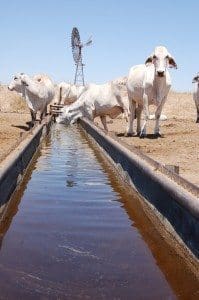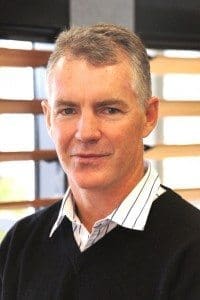LAND as far as the eye can see, but can your cattle use every available inch of pasture?
For many, the issue is simply one of a lack of water within a reasonable grazing radius – something that leaves large tracts of land across Australia’s northern pastoral areas either under-utilised or not utilised at all at drier times of year.
To combat the problem, an increasing number of landholders in the Barkly Tableland region either side of the Northern Territory/Queensland border are spending millions of dollars on water intensification. The question from a property perspective is, will these projects pay off and will they lift land values?
Australia’s biggest cattle producer is another Barkly landholder adopting intensification through the provision of more watering points, adding bores and poly pipe to transport water to where it is needed.
Over the last three to four years, the Australian Agricultural Co has been increasing the number of watering points across its Barkly properties, as well as adding new fencing to create more subdivisional paddocks.
Managing director Jason Strong said the development has allowed AA Co to better manage its stock. “Cattle can be moved to water points, allowing them to better utilise the available pasture,” he said.
And he’s confident water intensification will pay off in the longer term.
“Landholders have two options. One is not to do any development and buy more land. The second is to better-utilise the land you already have. Water intensification isn’t cheap, but we can justify the expense. We look at the total cost of the development on a beast/area basis. Generally that cost can be two thirds of what you might pay for buying additional country.”
Mr Strong thinks water intensification will test NT/northwestern Qld property valuations.
“If there are two properties side by side with a base AE that’s the same, but one’s had significant development and can run 50 percent more cattle because of water intensification, does that property get full credit for the improvement or are both properties valued the same way?” he asked.
Frank Peacocke, Darwin-based director with rural valuers, Herron Todd White, said NT cattle properties were valued by their carrying capacity, year-in year-out, over a range of seasons.
“A buyer will look at a property’s stocking records over 10 years and marry that with a property’s development. If it all makes sense, the buyer should be confident they can continue achieving those rates.”
“You’ve got to have those runs on the board to prove that you have reduced the cost per kilo of production by improving the economies of scale through the addition of new waters,” Mr Peacocke said.
“Our advice to clients is if they are going to undertake water development, they can’t sell the property the following year. It’s important to prove that it works over a range of seasons. I think five years would be adequate.”
Dr Steve Petty is the director of Spectrum, a respected consulting company looking at the development and improvement efficiencies of cattle businesses across Northern Australia.
He agrees with Mr Peacocke’s estimation. “I think the market’s perception of water-intensified properties in the region will be better understood in three to five years,” he said.
Dr Petty said while the market hadn’t been tested yet for holdings that had undergone such water improvements, cattle properties were purchased or sold on their carrying capacity.
“A typical valuation is carrying capacity multiplied by beast/area value. So, if you increase the carrying capacity of a property through waters intensification, the value has to increase in proportion.”
Mr Peacocke said since the live export crisis of 2011, there had been a big ‘drought’ of property sales in the region.
“Now there’s a cash flow, people have started developing their properties again. However, there haven’t been any cattle property sales in the NT to give valuers an indication of how much someone’s willing to pay for water intensification,” he said.
It seems valuers have a theory about what might happen.
Mr Peacocke said some people had been buying carefully-selected NT cattle stations with a view to unlocking their potential by putting in water.
“Intensification might cost between $200 and $600 for one additional head of carrying capacity. When Barkly properties are bought and sold for in excess of a $1000 per beast area, then that’s not a bad investment. There’s economic sense in that.”
Mr Peacocke said buyers would be seeking the cost benefits of intensification and how they translate to reduced operating costs or improved brandings.
“For someone to pay full price for a property that is fully-developed (cattle within a 3km walking radius of a watering point), they need to see good production records. I think you’d want to see the proof – how it translates to productivity.”
Beetaloo provides good example
Dr Petty believes water intensification will have a massive impact on property valuations, and cites Beetaloo as an example.
 A recent interview with Beef Central highlighted the issue. John Dunnicliff’s Beetaloo completed a 10-year, $40 million project to develop new waters and fencing. The ambitious development project increased the carrying capacity from 20,000 cattle 10 years ago to 85,000 – 90,000 head today.
A recent interview with Beef Central highlighted the issue. John Dunnicliff’s Beetaloo completed a 10-year, $40 million project to develop new waters and fencing. The ambitious development project increased the carrying capacity from 20,000 cattle 10 years ago to 85,000 – 90,000 head today.
According to Dr Petty, the carrying capacity of Beetaloo has risen to the point where it is now sustainably carrying three to four times the number of cattle it once did.
“Surely that property should be worth three to four times the previous value,” he said.
He likened the development to upgrading a house.
“The owner does not realise the cash benefit of that renovation until they sell it. If they look purely at the return on investment, taking out the capital gain aspect of it, I believe the operating efficiency of the business will improve, resulting in better returns, making the business more valuable.”



